STIHL TS 460 Owner's Manual
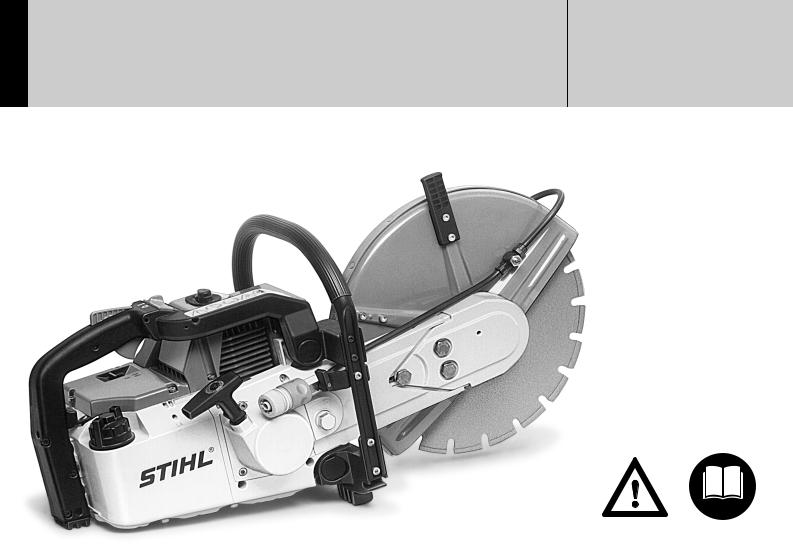
STIH)
STIHL TS 460 Cutquik®
Instruction Manual Manual de instrucciones
Warning!
Read and follow all safety precautions in Instruction Manual – improper use can cause serious or fatal injury.
Advertencia!
Lea y siga todas las precauciones de seguridad dadas en el manual de instrucciones – el uso incorrecto puede causar lesiones graves o mortales.
Contents
04.fm |
|
Guide to Using this Manual .............. |
2 |
|
|
Safety Precautions and |
|
||
006 01 |
|
Working Techniques ......................... |
3 |
|
|
Application Examples ..................... |
18 |
||
064_ |
|
STIHL composite resin |
|
|
|
cutting wheels |
21 |
||
SE_ |
|
|||
|
STIHL diamond cutting wheels |
21 |
||
_ |
|
|||
BA |
|
Assembling the |
|
|
|
|
|
||
|
|
bearing and guard .......................... |
25 |
|
|
|
Tensioning the V-belt ...................... |
26 |
|
|
|
Abrasive wheels ............................. |
27 |
|
|
recycled. |
Fitting / replacing an |
|
|
|
abrasive wheel |
28 |
||
|
|
|||
|
|
Fuel ................................................ |
29 |
|
|
can be |
Fueling ............................................ |
30 |
|
|
Starting / stopping the engine ......... |
31 |
||
|
paper |
Cleaning the air filter ...................... |
33 |
|
|
Motor Management |
35 |
||
|
oils; |
|||
|
Setting the carburetor ..................... |
35 |
||
paper.free-chlorineon vegetablecontaininks |
Spark arresting screen |
|
||
|
|
|
||
|
|
in the muffler ................................... |
36 |
|
|
|
Checking the Spark Plug ................ |
36 |
|
|
|
Replacing the starter rope |
|
|
|
|
and rewind spring ........................... |
37 |
|
Printed |
Printing |
Replacing the V-belt ....................... |
40 |
|
STIHL cut-off machine cart |
41 |
|||
|
|
|||
|
|
Storing the machine ........................ |
41 |
|
|
|
Maintenance chart .......................... |
42 |
|
2007KG,Co.& |
PrintedFSTin Germany |
Main parts of the machine .............. |
43 |
|
Warranty Statement ........................ |
47 |
|||
|
|
Specifications ................................. |
45 |
|
|
|
Special Accessories ....................... |
46 |
|
|
|
Maintenance and Repairs ............... |
46 |
|
|
|
STIHL Incorporated |
|
|
|
|
Federal Emission Control |
|
|
AG H7. |
Trademarks .................................... |
49 |
||
© ANDREAS STIHL |
0458 337 8621. M3. |
STIHl |
|
|
English / USA
Allow only persons who understand this manual to operate your cut-off machine.
To receive maximum performance and satisfaction from your STIHL cut-off machine, it is important that you read and understand the safety and maintenance precautions, starting on page 3, before using your cut-off machine.
Contact your STIHL dealer or the STIHL distributor for your area if you do not understand some instruction in this manual.
!Warning!
Because a cut-off machine is a highspeed cutting tool, some special safety precautions must be observed to reduce the risk of personal injury.
Careless or improper use may cause serious or even fatal injury.
TS 460 |
1 |
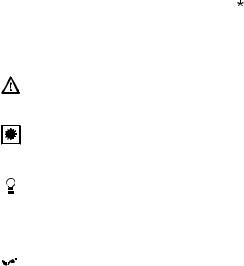
English / USA
Guide to Using this Manual
Pictograms
All the pictograms attached to the machine are shown and explained in this manual.
The operating and handling instructions are supported by illustrations.
Symbols in text
The individual steps or procedures described in the manual may be marked in different ways:
:A bullet marks a step or procedure without direct reference to an illustration.
A description of a step or procedure that refers directly to an illustration may contain item numbers that appear in the illustration.
Example:
Loosen the screw (1) Lever (2) ...
In addition to the operating instructions, this manual may contain paragraphs that require your special attention. Such paragraphs are marked with the symbols described below:
Warning where there is a risk of an accident or personal injury or
serious damage to property.
 Caution where there is a risk of damaging the machine or its individual components.
Caution where there is a risk of damaging the machine or its individual components.


 Note or hint which is not essential for using the machine, but may improve the operator’s understanding of the situation and result in better use of the machine.
Note or hint which is not essential for using the machine, but may improve the operator’s understanding of the situation and result in better use of the machine.

 Note or hint on correct procedure in
Note or hint on correct procedure in  order to avoid damage to the environment.
order to avoid damage to the environment.
Equipment and features
This instruction manual may refer to several models with different features. Components that are not installed on all models and related applications are marked with an asterisk (*). Such components may be available as special accessories from your STIHL dealer.
Engineering improvements
STIHL’s philosophy is to continually improve all of its products. As a result, engineering changes and improvements are made from time to time. If the operating characteristics or the appearance of your machine differ from those described in this manual, please contact your STIHL dealer for assistance.
Therefore some changes, modifications and improvements may not be covered in this manual.
2 |
TS 460 |

Safety Precautions and
Working Techniques
!Warning!
The use of any cut-off machine may be
hazardous. Because a cut-off machine is a high-
speed, fast-cutting power tool, special safety precautions must be observed to reduce the risk of personal injury and fire.
It is important that you read, fully understand and observe the following safety precautions and warnings.
Read the instruction manual and the safety precautions periodically.
Do not lend or rent your cut-off machine without the instruction manual. Be sure that anyone using your cut-off machine understands the information contained in this manual. A first-time operator should obtain practical instruction before using the machine. Employers should establish a training program for operators of gasoline-powered, handheld portable, cut-off machines to assure safe operation of these machines. These safety precautions and warnings apply to the use of all STIHL Cutquiks.
!Warning!
Careless or improper use of any cut-off machine may cause serious or fatal injury.
Have your STIHL dealer show you how to operate your cut-off machine. Observe all applicable national, state and local safety regulations, standards and ordinances.
!Warning!
Minors should never be allowed to use a cut-off machine. Bystanders, especially children, and animals should not be allowed in the area where a cut-off machine is in use. Never let the cut-off machine run unattended.
Different models may have different parts and controls. See the appropriate section of your instruction manual for a description of the controls and function of the parts of your model cut-off machine.
Safe use of a cut-off machine involves
–the operator
–the cut-off machine
–the use of the cut-off machine.
English / USA
THE OPERATOR
Physical Condition
You must be in good physical condition and mental health and not under the influence of any substance (drugs, alcohol, etc.) which might impair vision, dexterity or judgment. Do not operate a cut-off machine when you are fatigued. Be alert - if you get tired while operating your cut-off machine, take a break; tiredness may result in loss of control. Working with any cut-off machine can be strenuous. If you have any condition that might be aggravated by strenuous work, check with your doctor before operating a cut-off machine.
TS 460 |
3 |

English / USA
!Warning!
Prolonged use of cut-off machines (or other machines) exposing the operator to vibrations may produce whitefinger disease (Raynaud's phenomenon) or carpal tunnel syndrome. These conditions reduce the hand's ability to feel and regulate temperature, produce numbness and burning sensations and cause nerve and circulation damage and tissue necrosis. All factors which contribute to whitefinger disease are not known, but cold weather, smoking and diseases or physical conditions that affect blood vessels and blood transport, as well as high vibration levels and long periods of exposure to vibration are mentioned as factors in the development of whitefinger disease. In order to reduce the risk of whitefinger disease and carpal tunnel syndrome, please note the following:
–Most STIHL cut-off machine models are available with an anti-vibration ("AV") system designed to reduce the transmission of vibrations created by the engine to the operator's hands. An AV system is recommended for those persons using cut-off machines on a regular or sustained basis.
–Wear gloves and keep your hands warm.
–Keep the AV system well maintained. A cut-off machine with loose components or with damaged or worn AV buffers will tend to have higher vibration levels.
–Maintain a firm grip at all times, but do not squeeze the handles with constant, excessive pressure. Take frequent breaks.
All the above-mentioned precautions do not guarantee that you will not sustain whitefinger disease or carpal tunnel syndrome. Therefore, continual and regular users should monitor closely the condition of their hands and fingers. If any of the above symptoms appear, seek medical advice immediately.
!Warning!
The ignition system of your unit produces an electromagnetic field of a very low intensity. This field may interfere with some pacemakers. To reduce the risk of serious or fatal injury, persons with a pacemaker should consult their physician and the pacemaker manufacturer before operating this tool.
Proper Clothing
!Warning!
To reduce the risk of injury, the operator should wear proper protective apparel.
Clothing must be sturdy and snug-fitting, but allow complete freedom of movement. Avoid loose-fitting jackets, scarfs, neckties, jewelry, flared or cuffed pants, unconfined long hair or anything that could become caught on any obstacles or moving parts of the unit. Wear overalls or long pants to protect your legs. Do not wear shorts.
4 |
TS 460 |
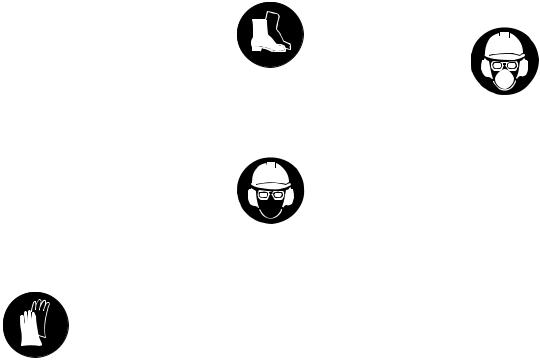
English / USA
!Warning!
When cutting metal, a cut-off machine generates sparks that can ignite clothing. Most fabrics used in clothing are flammable - even flame-retardant fabrics will ignite at higher temperatures. To reduce the risk of burn injury STIHL recommends wearing clothing made of leather, wool, flame-retardant-treated cotton or a tightly woven, heavier cotton such as denim. Some flame-retardant synthetic fabrics are also suitable but others such as polyester, nylon, rayon and acetate can melt during a fire into a tar-like matter that burns into the skin. Check the clothing manufacturer's instructions. Keep clothing free of oil, fuel, grease and other flammable substances.
Always wear gloves when handling the cut-off machine. Heavy-duty, nonslip gloves improve your grip and help to protect your hands.
Good footing is most important in cut-off machine work.
Wear sturdy boots with nonslip soles. Steel-toed
safety boots are recommended.
!Warning!
Loose objects may be thrown toward the operator by the cutting tool.
To reduce the risk of injury to your eyes never operate a cut-off machine unless wearing goggles or
properly fitted safety glasses with adequate top
and side protection complying with ANSI Z 87.1. Proper eye protection is a must.
Wear an approved safety hard hat to protect your head. Cut-off machine noise may damage your hearing. Always wear sound barriers (ear plugs or ear mufflers) to help protect your hearing. Regular users should have their hearing checked regularly.
!Warning!
When wet cutting is not utilized, the operator should always wear a respirator approved by
NIOSH/MSHA for the material being cut to
reduce the risk of serious or fatal respiratory illness. For additional details and warnings on this subject, see information under "Working Conditions" in this instruction manual.
THE CUT-OFF MACHINE
For illustrations and definitions of the parts of the cut-off machine, see "Main parts of the machine."
!Warning!
Never modify a cut-off machine in any way. Only attachments supplied by STIHL or expressly approved by STIHL for use with the specific STIHL cut-off machine models are authorized. Although certain unauthorized attachments are useable with the STIHL powerhead, their use may, in fact, be extremely dangerous.
TS 460 |
5 |

English / USA
!Warning!
Dust may collect on the powerhead, especially around the carburetor, and may absorb gasoline resulting in danger of fire. Clean dust from the powerhead regularly.
Abrasive Wheels
!Warning!
Before mounting the cutting wheel, make sure that the maximum operating wheel speed is above or equal to the spindle speed of your cut-off machine as provided in the Specifications of this manual. A wheel that is not so rated may shatter or break and poses a threat of serious or fatal injury to the operator and other nearby persons.
Abrasive wheels for free-hand cutting are subjected to particularly high bending and compression stresses.
!Warning!
Unauthorized wheels may be more likely to shatter or break. Use only STIHL wheels or other authorized wheels with approved RPM ratings. Read and follow any addional safety precautions that accompany the wheel.
!Warning!
Inspect the abrasive wheel frequently and
replace immediately if the
abrasive wheel is cracked or warped. Cracked or warped wheels may
shatter or break and cause serious or fatal personal injury. Out-of-round or unbalanced abrasive wheels increase vibration and reduce the service life of the cut-off machine.
Abrasive wheels are heat sensitive. Always store your cut-off machine in a place where the cutting wheel is not exposed to direct sunlight or other sources of heat. Store spare cutting wheels in a dry place where there is no risk of frost damage. Failure to follow these directions may cause the wheel to shatter or crack in use causing serious or fatal injury.
!Warning!
Never use circular saw blades, carbide tipped blades, rescue blades, wood-cutting blades or
toothed blades of any nature. They can cause
severe personal injury from blade contact, thrown objects and/or reactive forces, including kickback. See section on “Reactive Forces.“ Your STIHL dealer stocks a range of special abrasive wheels for the many applications of the cut-off machine.
!Warning!
Use of the wrong abrasive wheel or the cutting of material for which the wheel was not designed may cause the wheel to shatter causing serious or fatal injury.
Only use the abrasive wheel approved for the type of material to be cut. There are different abrasive wheels, each specially marked. For example:
6 |
TS 460 |
English / USA
1.Stone
Also can be used for concrete, masonry, reinforced concrete and brick cutting.
2.Steel
Can be used for all ferrous metal cutting.
3.Asphalt
Also can be used for aggregate concrete cutting.
4.Ductile iron
Also can be used for certain grades of cast iron (SG 17-24), bronze and copper cutting.
For cutting composite materials please ask your STIHL dealer.
Diamond Abrasive Wheels
Diamond abrasive wheels have a much better cutting performance than composite abrasive wheels. The diamond wheels are steel centered, and diamond particles are imbedded in their cutting edges.
They can be used for concrete, asphalt, natural stone, clay pipe, brick and the like.
They are not normally suitable for cutting metal or other materials.
Wet or dry cutting is possible. With wet cutting your diamond wheel will have a longer life. Water attachments are included with your STIHL cut-off machine. See the appropriate section of your instruction manual.
!Warning!
Do not remount a used diamond abrasive wheel without first inspecting for under-cutting, flatness, core fatigue, segment damage or loss, signs of overheating (discoloration) and possible arbor hole damage.
Check the wheel for cracks and make sure that no pieces have broken off the wheel before use.
Always fit the wheel so that the arrow on the wheel points in the direction of the rotation of the spindle.
THE USE OF THE CUT-OFF MACHINE
Transporting the STIHL Cutquik
!Warning!
Always stop the engine before putting a cut-off machine down or carrying it. The abrasive wheel continues to rotate for a short while after the throttle trigger is released (flywheel effect). Carrying a cut-off machine with the engine running is extremely dangerous. Accidental acceleration of the engine can cause the wheel to rotate. Avoid touching the hot muffler.
By hand: When carrying your cut-off machine by hand, the engine must be stopped and the cut-off machine must be in the proper position. Grip the front handle and place the muffler at the side away from the body.
!Warning!
Always protect the cutting wheel from hitting the ground or any other objects. Damaged wheels may shatter and cause serious or fatal injury.
TS 460 |
7 |
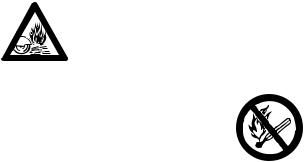
English / USA
By vehicle: Properly secure your cut-off machine to prevent turnover, fuel spillage and damage to the cut-off machine. Never transport with cutting wheel mounted. A wheel damaged during transportation may shatter during operation and cause serious personal injury.
Preparation for the Use of the Cut-Off Machine
For assembly, follow the procedure described in the appropriate section of your instruction manual.
Keep the handles dry, clean and free of oil and fuel.
!Warning!
Before operation of your cut-off machine, be sure the controls (e.g. throttle trigger, stop switch) and the safety devices are working properly, the carburetor idle and maximum speed are correctly adjusted, the wheel is properly mounted, and the wheel guard is in place and securely fastened to your unit. All wheels should be carefully inspected for good condition before mounting.
Adjust the wheel guard so that sparks, dust and cut
material are deflected
away from the operator, and cannot reach flammable surroundings.
See section “Operating Instructions“ of your instruction manual.
Never operate a cut-off machine that is damaged, improperly adjusted or not completely and securely assembled. Inspect for safety in operation.
Proper tension of the V-belt is important. In order to avoid an incorrect setting, the tensioning procedure must be followed as described in your manual. Always make sure the hexagonal collar nuts for the cast arm are tightened securely. Check V-belt tension after one hour of operation and correct if necessary.
Fuel
Your STIHL power tool uses an oilgasoline mixture for fuel (see the chapter on “Fuel” of your instruction manual).
!Warning!
Gasoline is an extremely flammable fuel. If spilled and ignited by a spark or
other ignition source, it can cause fire and serious burn injury or property
damage. Use extreme caution when handling gasoline or fuel mix.
Do not smoke or bring any fire or flame near the fuel or the power tool. Note that combustible fuel vapor may escape from the fuel system.
Fueling Instructions
!Warning!
Fuel your power tool in well-ventilated areas, outdoors. Always shut off the engine and allow it to cool before refueling. Gasoline vapor pressure may build up inside the fuel tank depending on the fuel used, the weather conditions and the tank venting system.
In order to reduce the risk of burns and other personal injury from escaping gas vapor and fumes, remove the fuel filler cap on your power tool carefully so as to allow any pressure build-up in the tank to release slowly. Never remove the fuel filler cap while the engine is running.
8 |
TS 460 |
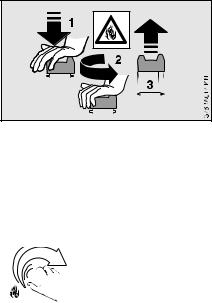
English / USA
Select bare ground for fueling and move at least 10 feet (3 m) from the fueling spot before starting the engine. Wipe off any spilled fuel before starting your machine.
!Warning!
Check for fuel leakage while refueling and during operation. If fuel leakage is found, do not start or run the engine until the leak is fixed and any spilled fuel has been wiped away. Take care not to get fuel on your clothing. If this happens, change your clothing immediately.
!Warning!
If fuel gets spilled on clothes, especially trousers, it is very important to change clothes immediately. Do not rely upon evaporation. Flammable quantities of fuel may remain on clothes after a spill for longer than expected. Cutting metal with a cut-off machine when clothes are wet or damp from gasoline is extremely dangerous, as the operator's clothes might catch fire and cause serious or fatal injury.
!Warning!
An improperly tightened fuel cap can loosen or come off and spill quantities of fuel.
Different cut-off machines may be equipped with different fuel filler caps:
Bayonet filler cap
Never use a tool to open or close the bayonet filler cap, as this could damage the cap and cause fuel to leak out.
The bayonet filler cap must be closed with care after refuelling.
Fuel filler cap with screw thread
Secure the fuel filler cap as tightly as possible after 


 refuelling.
refuelling.
This reduces the risk of the cap working loose due to engine vibrations and fuel leaking out.
!Warning!
Never attempt to force the cap open by using a tool. It may damage the cap and allow fuel to leak.
Before use, make sure that the fuel cap has been properly tightened and any spilled fuel wiped away. Check for fuel leakage while refueling and during operation. If a fuel leak is suspected, do not start or run the engine until the leak is fixed and spilled fuel has been wiped away.
TS 460 |
9 |
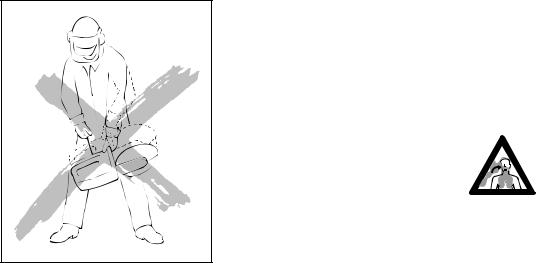
English / USA
Starting
002BA058 KN
!Warning!
Your cut-off machine is a one-person tool. Do not allow other persons to be near the cut-off machine. Start and operate your cut-off machine without assistance. For specific starting instructions, see the appropriate section of your instruction manual.
Do not drop start. This method is very dangerous because you may lose control of the cut-off machine.
Place the cut-off machine on firm ground or other solid surface in an open area. Maintain good balance and secure footing. Be absolutely sure that the cutting wheel is clear of you and all other obstructions and objects, including the ground. When the engine starts at starting-throttle, engine speed will be fast enough for the clutch to engage the V-belt pulley and turn the wheel. Never attempt to start the cut-off machine when the abrasive wheel is in a cut.
Once the engine has started, immediately blip the throttle trigger, which should release the starting throttle and allow the engine to slow down to idle.
!Warning!
When you pull the starter grip, don't wrap the starter rope around your hand. Do not allow the grip to snap back, but guide the starter rope slowly back to permit the rope to rewind properly. Failure to follow this procedure may result in injuries to hand or fingers and may damage the starter mechanism.
Working Conditions
Operate the cut-off machine under good visibility and daylight conditions only.
Wearing of hearing protection reduces sound perception. Be alert not to miss voice signals from co-workers. Keep within calling distance to other persons who may assist in case of emergency.
!Warning!
Your cut-off machine produces toxic exhaust
fumes as soon as the combustion engine is running. These gases (e.g. carbon monoxide)
may be colorless and odorless. To reduce the risk of serious or fatal injury from breathing toxic fumes, never run the cut-off machine indoors or in poorly ventilated locations. Ensure proper ventilation when working in trenches or other confined areas.
10 |
TS 460 |
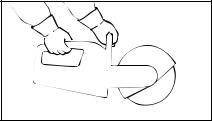
English / USA
!Warning!
Use of this product to cut masonry, concrete, metal and other materials can generate dust and fumes containing chemicals known to cause serious or fatal injury or illness, such as respiratory disease, cancer, birth defects or other reproductive harm. If you are unfamiliar with the risks associated with the particular material being cut, review the material safety data sheet and/or consult your employer, the material manufacturer/supplier, governmental agencies such as OSHA and NIOSH and other sources on hazardous materials. California and some other authorities, for instance, have published lists of substances known to cause cancer, reproductive toxicity, etc. Control dust and fumes at the source where possible. In this regard use good work practices and follow the recommendations of the manufacturer/ supplier, OSHA/NIOSH, and occupational and trade associations. A water attachment kit is provided with your cut-off machine and should be used for dust suppression when wet cutting is feasible. If wet cutting is not utilized, the operator and any bystanders should always wear a respirator approved by NIOSH/MSHA for the material being cut. Consult and follow any federal, state or local laws or regulations with respect to dry and wet cutting.
!Warning!
Cutting masonry, concrete and other materials with silica in their composition may give off dust containing crystalline silica. Silica is a basic component of sand, quartz, brick clay, granite and numerous other minerals and rocks. Repeated and/or substantial inhalation of airborne crystalline silica can cause serious or fatal respiratory diseases, including silicosis. In addition, California and some other authorities have listed respirable crystalline silica as a substance known to cause cancer. When cutting such materials, always follow the respiratory precautions mentioned above.
!Warning!
Breathing asbestos dust is dangerous and can cause severe or fatal injury, respiratory illness or cancer. The use and disposal of asbestos-containing products have been strictly regulated by OSHA and the Environmental Protection Agency. Do not use your cut-off machine to cut or disturb asbestos, asbestoscontaining products, or products such as pipes which are wrapped or covered with asbestos insulation. If you have any reason to believe that you might be cutting asbestos, immediately contact your employer or a local OSHA representative.
002BA060 KN
!Warning!
Your STIHL cut-off machine is designed for hand-held use or operation on a cutoff machine cart. Cutting with your cutoff machine resting on the ground or other surface can cause excessive wear to the bracket designed to protect the bottom of the tank housing. Loss of fuel and personal injury from fire may result. Replace damaged or badly worn brackets immediately.
Grip: Never use the cut-off machine with one hand. Always hold the cut-off machine firmly with both hands when the engine is running. Place your left hand on front handle bar and your right hand on rear handle and throttle trigger. Lefthanded users should follow this instruction too.
TS 460 |
11 |
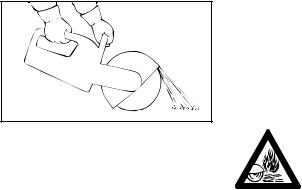
English / USA
002BA061 KN |
Wrap your fingers tightly around the handles, keeping the handles cradled between your thumbs and forefingers. Make sure your cut-off machine handles and grip are in good condition and free of moisture, pitch, oil or grease.
!Warning!
Clear the area where you are working. Avoid stumbling on obstacles and watch out for holes or ditches. Be extremely cautious when working on slopes or uneven ground. Take extreme care in wet and freezing weather (rain, snow, ice).
!Warning!
Never operate the cut-off machine with the starting-throttle lock engaged as this does not permit proper control of the speed of the unit and may lead to serious injury.
!Warning!
Sparks from cutting metal can burn or cause
clothing to catch fire.
Always direct sparks away from the operator or any flammable
surroundings. Never cut metal while standing on a flammable surface, such as wood or tar paper. Where there is a risk of fire, have appropriate fire extinguishing equipment readily available.
!Warning!
To reduce the risk of injury from fire, do not cut into any pipe, drum or other container without first ensuring that it does not contain a volatile or flammable substance.
!Warning!
When cutting into existing walls, floors or similar structures, be alert for hidden hazards such as electrical cables, water and gas pipes and flammable substances. Make sure that power, water and gas have been shut off and pipes drained before starting to cut.
Operating Instructions
!Warning!
The wheel guard is adjustable. It is extremely important that the wheel guard is in place and set to suit the type of work and your stance. The guard should always be adjusted so that the user is not endangered by particles of the material being cut, sparks or pieces of damaged wheels either directly or by ricochet. Failure to follow this instruction could result in serious or fatal injury.
!Warning!
Always check the wheel before use and after unintentionally striking any object; frequently check it during use when it is stopped. Look for cracks, and make sure that it is undamaged and in good condition and that no pieces have broken off. See sections on "Abrasive Wheels" and "Reactive Forces" in this manual. Check the wheel guard for cracks. If you discover any breaks or cracks, fit a new guard before further use.
12 |
TS 460 |
English / USA
!Warning!
It is essential to determine the exact direction of the cut before applying the abrasive wheel to the work. Wheels are constructed for radial pressure only. Lateral pressure must be avoided. Hold the cut-off machine steady. To reduce the risk of serious or fatal injury, do not change the direction of the cut during the cut as this may produce a high torsional load on the abrasive wheel and may cause it to break or shatter.
!Warning!
Do not use abrasive wheels for rough grinding. Large bending stresses occur during such work and abrasive wheels may shatter or break and could cause serious or fatal injury.
!Warning!
To reduce the risk of injury from shattered abrasive wheels:
1.Do not exceed the maximum operating speed marked on the wheel.
2.Do not use a wheel that has been dropped.
3.Test each new wheel immediately after installation for approximately one minute at maximum speed without cutting, making sure to keep bystanders away.
4.Do not cut any material for which the abrasive wheel is not authorized.
5.Do not grind on the side of the abrasive wheel.
6.Do not twist, thrust, knock or drop the machine. This can cause damage to the wheel.
To achieve a clean and efficient cut, pull the abrasive wheel across the work or move it "to and fro" in the cutting direction. Do not use force to push the abrasive wheel into the work.
Insert the wheel into the material only as deep as necessary to make the cut. To reduce the amount of dust created, do not cut all the way through stone and concrete materials - leave a thin piece uncut. For most such materials, this piece can be easily broken afterwards. Do not cock, jam or wedge the wheel in the cut.
Always stop the engine and be sure the wheel has stopped rotating before setting down the cut-off machine.
If a cut-off machine cart is used, sweep debris from the path of the wheels, as debris under one of the cart’s wheels may cause flexing of the abrasive wheel. This could result in high frictional forces and thus greatly reduce the engine power available for the actual cutting work. It could also damage the abrasive wheel.
STIHL recommends the use of the cart for longer cuts in a straight line.
Wet Cutting with Abrasive Wheels
Before wet cutting, make sure water will not damage the floor or building.
!Warning!
To reduce the risk of electrocution to you or bystanders, do not allow water or sludge to contact live electric wires.
!Warning!
To reduce the risk of injury from wheel breakage when wet cutting with a composite non-diamond wheel:
1.Never store and re-use a wheel that has been used with water. Use these wheels up the same day.
TS 460 |
13 |
English / USA
2.Make certain water does not flow on a wheel that is not running, since the wheel will absorb water, which will affect wheel balance.
3.Shut water off before the wheel stops so that excess water will be dissipated.
4.Be certain water is applied to both sides of wheel, since uneven distribution can cause "one sided" wear.
Important Adjustments
At correct idle speed, the wheel should not turn. For directions to adjust idle speed, see the appropriate section of your instruction manual.
!Warning!
Do not use a cut-off machine with incorrect idle speed adjustment. The rotating wheel may cause injury. Have your STIHL dealer check your cut-off machine and make proper adjustments or repairs.
Never touch a rotating wheel with your hand or any part of your body.
Reactive Forces including Kickback
!Warning!
Reactive forces may occur at any time the cutting wheel on a cut-off machine is rotating. If the wheel is slowed or stopped by frictional contact with any solid object or by a pinch, reactive forces may occur instantly and with great force. These reactive forces may result in the operator losing control of the cut-off machine, which may, in turn, result in serious or fatal injury.
An understanding of the causes of these reactive forces may help you avoid loss of control. Reactive forces are exerted in a direction opposite to the direction in which the wheel is moving at the point of contact or pinch.
Pull-away, climbing, pinching and rotational kickback forces
The most common reactive forces are pull-away and climbing. If the contact is at the bottom of the wheel, a cut-off machine will try to pull away from the operator (pull-away). If the contact is at the front of the wheel, the wheel may attempt to climb the object being cut (climbing). Pinching occurs when the piece being cut closes on the wheel. If the wheel is severely pinched at the front, especially in the upper quadrant, the wheel may be instantly thrown up and back towards the operator with great force in a rotational kickback motion.
The greater the force generated, the more difficult it will be for the operator to control the cut-off machine. Any of the reactive forces can, in some circumstances, cause the operator to lose control of a cut-off machine, allowing the rotating wheel to come into contact with the operator. Severe personal injury or death can result.
14 |
TS 460 |
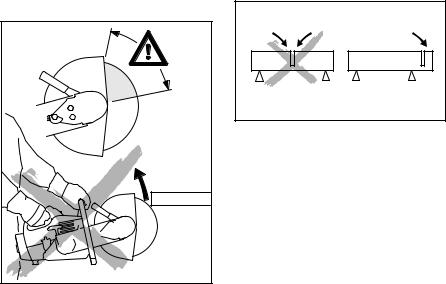
English / USA
Reducing the Risk of Kickback Injury
002BA242 KN |
!Warning!
To reduce the risk of kickback injury, avoid cutting with the upper quadrant of the wheel where possible. Be especially cautious for a pinching of the wheel in this area, which can cause severe reactive forces in a rotational kickback motion.
002BA146 KN |
Be alert to potential movement of the work piece or anything else that could cause the cut to close and pinch the wheel. In order to reduce the risk of pinching, support the work piece in such a way that the cut remains open during the cutting process and when the cut is finished (see illustration). Never make a cut that results in a binding of the wheel.
!Warning!
Be particularly alert when cutting a work piece that, if not properly supported, can sag upon completion of the cut, creating a pinch not where you are actually cutting but, rather, at or near the top of the work piece (see illustration). If that pinch is in the upper quadrant of the abrasive wheel, kickback can result.
!Warning!
Use only cutting attachments authorized by STIHL. Never use chipped abrasive wheels, circular saw blades, carbidetipped blades, rescue blades or woodcutting or toothed blades of any nature on a cut-off machine. The use of such wheels or blades will greatly increase the risk of loss of control and severe personal injury or death from reactive forces, since the chipped section of an abrasive wheel, or the teeth of a saw blade may catch in the material being cut and generate substantially greater reactive forces, including rotational kickback.
Cut-off machines are designed for use with abrasive wheels in good condition only. Machines designed for use with wood-cutting or other toothed blades use different types of guarding systems which provide the protection necessary for those types of blades. Machines, such as a cut-off machine, that are designed for use with abrasive wheels, require a different guarding system, which is not designed to provide protection against all dangers presented by circular saw blades, carbide-tipped blades, rescue blades or wood-cutting or toothed blades of any nature.
TS 460 |
15 |
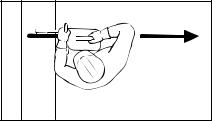
English / USA
002BA059 KN
!Warning!
To reduce the risk of injury from loss of control from reactive forces, including kickback:
1.Hold the cut-off machine firmly with both hands.
2.Maintain good balance and footing at all times. Never cut while standing on a ladder.
3.Position the cut-off machine in such a way that your body is clear of the cutting attachment. Avoid standing in direct line with the wheel. Never bend over the cutting attachment, especially when the guard is pulled back towards the top and there is a risk of reactive forces.
4.Do not cut above shoulder height.
5.Do not cut wood or any other material for which the abrasive wheel is not authorized.
6.Never use circular saw blades, carbide-tipped blades, rescue blades, wood-cutting blades or toothed blades of any nature. Their use increases the risk of injury from blade contact, thrown tips and reactive forces, including kickback.
7.Begin cutting and continue at full throttle.
8.Do not overreach.
9.Use your cut-off machine for cutting only. It is not designed for prying or shoveling away any objects.
10.Be especially alert for reactive forces, including kickback, when cutting with the front and upper quadrant of the wheel.
11.Be alert to shifting of the work piece or anything that could cause the cut to close and pinch the wheel, especially in the upper quadrant. Support the work piece in such a way that the cut remains open. Never make a cut that results in a binding of the wheel.
12.Use wet cutting if feasible. In a pinch situation the water can act as a lubricant and reduce the energy of reactive forces.
13.Release the pressure on the cut-off machine as you reach the end of the cut. Too much pressure may cause the operator to lose control of the cut-off machine when the abrasive wheel completes the cut. The abrasive wheel may contact the operator or strike some foreign object and shatter.
14.Use extreme caution when reentering a cut and do not turn the wheel at an angle or push the wheel into the cut as this may result in a pinching of the wheel.
Gyroscopic Forces
Be alert for gyroscopic forces that are caused by the rapid spinning of the cutoff wheel. These forces result in opposition to directional change, e.g. when the operator attempts to move the machine in a sideways direction.
16 |
TS 460 |
English / USA
Maintenance, Repair and Storing of the Cut-Off Machine
Maintenance, replacement, or repair of the emission control devices and systems may be performed by any nonroad engine repair establishment or individual. However, if you claim warranty for a component which has not been serviced or maintained properly or if nonapproved replacement parts were used, STIHL may deny warranty.
Never operate a cut-off machine that is damaged, improperly adjusted or not completely or securely assembled. Follow the maintenance and repair instructions in the appropriate section of your owner's manual.
!Warning!
Use only STIHL replacement parts for maintenance and repair. Use of parts manufactured by others may cause serious or fatal injury.
!Warning!
Always stop the machine, make sure that the wheel is stopped, and remove the spark plug boot from the spark plug before doing any maintenance or repair work or cleaning the cut-off machine. Do not attempt any maintenance or repair work not described in your instruction manual. Have such work performed at your STIHL service shop only.
Clean off grinding dust after finishing work. Tighten all nuts, bolts and screws except the carburetor adjustment screws after each use.
!Warning!
Never test the ignition system with spark plug boot removed from spark plug or with unseated spark plug, since uncontained sparking may cause a fire.
!Warning!
To reduce the risk of fire and burn injury, use only spark plugs authorized by STIHL. Always press spark plug boot snugly onto spark plug terminal of the proper size. (Note: If terminal has detachable SAE adapter nut, it must be attached.) A loose connection between spark plug terminal and ignition wire connector in the boot may create arcing that could ignite combustible fumes and cause a fire. Keep spark plug clean, and make sure ignition lead is in good condition.
!Warning!
Do not operate your cut-off machine if the muffler is damaged, missing or modified. An improperly maintained muffler will increase the risk of fire and hearing loss. Never touch a hot muffler or spill fuel or other flammable liquid over it. Burn injuries or fire will result. If your muffler was equipped with a sparkarresting screen to reduce the risk of fire (e. g. in the USA, Canada and Australia), never operate your cut-off machine if the screen is missing or damaged.
For any maintenance please refer to the maintenance chart and to the warranty statement near the end of the instruction manual.
Store wheels on a flat surface in a dry place, preferably at a constant temperature, where there is not a risk of frost. Do not store a cut-off machine with a wheel mounted on the machine. Store cut-off machine in a high or locked place, away from children.
Empty the fuel tank before storing for longer than a few days. Store fuel only in correctly labeled and approved containers. Avoid direct skin contact and do not inhale the gas vapors.
TS 460 |
17 |
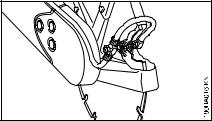
English / USA
Application Examples
Most diamond cutting wheels are suitable for wet cutting
Wet cut whenever feasible. It increases the service life and cutting speed of diamond cutting wheels
Ensure that the cutting wheel is generously supplied with water, up to 10 liters per minute.
Wet cutting helps to suppress dust.
The water binds the dust.
The cutting wheel must be supplied with at least 0.6 liters water per minute.
Wet cutting can reduce the energy of reactive forces. In a pinch situation, the water can act as a lubricant.
Water connection
–A water attachment kit is mounted on the machine, for use with all types of water supply.
–A pressurized 10 liter water tank is available from STIHL for dust suppression.
–A water tank for mounting on the Cutquik cart is also available for dust suppression.
Composite resin cutting wheels can be used for dry cutting of metals or for wet or dry cutting of concrete, stone or masonry.
Special procedures must be followed when dry cutting with a composite nondiamond wheel. See in the section entitled „Wet Cutting with Composite Wheels“ lin the safety precautions of this manual. Wet cutting is generally not suitable for cutting metals.
Respiratory protection
!Warning!
When wet cutting is not utilized, the operator and any bystanders should always wear a respirator approved by NIOSH/MSHA for the material being cut.
Points to be noted with diamond and composite resin cutting wheels
Object to be cut
–Must be fully supported
–Must be secured so that it cannot roll or slip away
–Must be protected against vibration
The cutting sequence
The cutting sequence is important when cutting openings and recesses, etc. The last cut must always be made in such a way that the cutting wheel cannot become bound and so that the user is not at risk of being injured by the part that has been cut off or out.
If applicable, leave small ridges of uncut material to hold the severed part in position. These ridges can subsequently be broken through.
A number of points must be decided before the part is finally severed:
–How heavy is the part?
–In which direction can it move after being severed?
–Is it under tension?
Helpers must not be put at risk of injury when the part is broken off or out.
18 |
TS 460 |
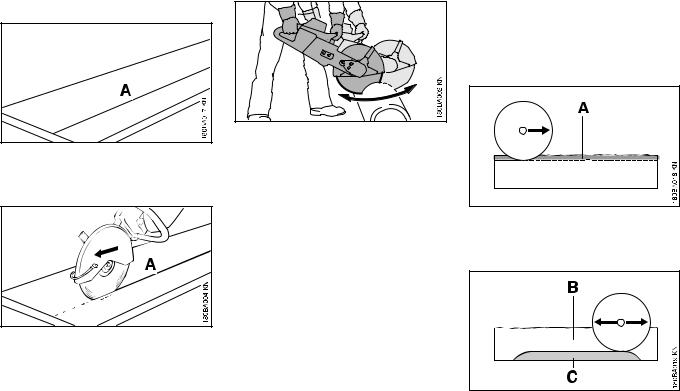
English / USA
Cutting in several passes
A = Mark cutting line |
:Thick-walled workpieces should be cut with a uniform swinging movement, back and forth.
Cutting slabs
:Place the slab securely on a nonslip surface.
A = Cut a guiding groove along the marked line.
:Work along the cutting line. If corrections are necessary, always reposition the cutting wheel, taking care to ensure that it is not wedged. The cutting depth per pass should not exceed 5 to 6 cm (2“ to 2 1/2“. Thicker material must be cut in several passes.
B = Cut deeper into the parting cut with uniform back-and-forth movements.
C = Leave a ridge of uncut material.
:Cut through the slab at the ends so the material does not chip.
:Then break the slab.
TS 460 |
19 |
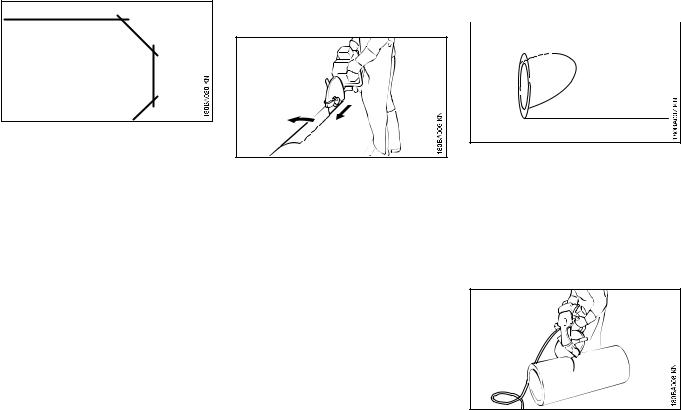
English / USA
Cutting round and hollow |
Cutting shapes on pipes |
|
|
workpieces |
|
|
|
|
|
|
|
|
|
|
|
:Curves must be cut in several straight passes, taking care to ensure that the cutting wheel does not become wedged.
:Pipes and round objects, etc. must be secured so that they cannot roll.
:Avoid reinforcing elements, especially in the direction of the cut, when deciding on the cutting line.
:Cut a guiding groove along the marked line.
:Cut deeper into the parting cut with uniform back-and-forth movements. Advance the cutting wheel along the guiding groove at full cutting depth. Always reposition the cutting wheel, taking care not to wedge it, if the cutting direction has to be corrected slightly. If necessary, leave small ridges of uncut material to hold the severed part in position. These ridges can subsequently be broken through.
:Mark the cutting line.
!Warning!
Particular care and precision are required for free-hand cutting along such cutting lines. Avoid side-loading the wheel or causing it to bind.
:Cut a guiding groove along the marked cutting line, starting at the top and moving out towards both sides.
:Cut into the pipe or round object, etc. at the ends of the cutting line so that the material does not chip.
20 |
TS 460 |

:Cut deeper into the parting cut with uniform back-and-forth movements, starting at the top and moving out towards the sides. Advance the cutting wheel along the guiding groove at full cutting depth. Always reposition the cutting wheel afresh, taking care not to wedge it if the cutting direction has to be corrected slightly. If necessary, leave small ridges of uncut material to hold the severed part in position. These ridges can subsequently be broken through.
STIHL composite resin cutting wheels
Economic benefit is improved and premature wear can be avoided by choosing and using the correct composite resin cutting wheel. The short name (e.g. “asphalt“, “concrete“)
–on the label and
–on the packaging (table with recommended uses)
can help to ensure the correct choice.
STIHL composite resin cutting wheels cannot be used to cut railway tracks.
English / USA
STIHL diamond cutting wheels
Economic benefit is improved and premature wear can be avoided by choosing and using the correct diamond cutting wheel. The short name (see following explanation)
–on the label and
–on the packaging (table with recommended uses)
can help to ensure the correct choice.
TS 460 |
21 |
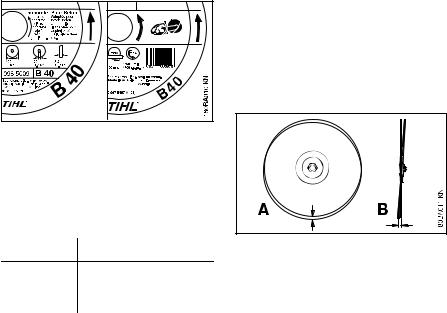
English / USA
Short names
The short name is a combination of letters and numerals with up to four digits:
:The letters indicate the main area of use for the cutting wheel.
Letter |
Main area of use |
AAsphalt
BConcrete
SStone (rock)
:The numerals indicate the performance class of the STIHL diamond cutting wheel.
Radial and axial run-out
A correctly mounted spindle bearing on the cut-off machine is essential for a long service life and efficient operation of the diamond cutting wheel.
Using a cutting wheel on a cut-off machine with defective spindle bearing can lead to axial and radial run-out.
Excessive radial run-out (A) causes individual diamond segments to be overloaded and to overheat. This can in turn lead to stress cracking in the wheel core or to softening of individual segments.
Axial run-out or wobble (B) results in higher thermal stress and wider cuts.
22 |
TS 460 |
English / USA
Troubleshooting
Cutting wheel
Problem |
Cause |
Remedy |
|
|
|
|
|
Frayed edges or tears, cut wanders out |
Radial or axial run-out |
Consult a dealer1) |
|
of line, increased wear at the sides of the |
|
|
|
segments |
|
|
|
|
Cutting wheel wobbles |
Use a new cutting wheel |
|
|
|
|
|
Frayed edges, cut wanders out of line, |
Cutting wheel is blunt; built-up edges on |
Dress the cutting wheel for stone by |
|
little or no cutting performance, sparking |
cutting wheels for stone |
briefly cutting in abrasive material; use a |
|
|
|
|
new cutting wheel for cutting asphalt |
|
|
|
|
Poor cutting performance, high level of |
Cutting wheel rotates in the wrong direction |
Mount the cutting wheel with correct |
|
segment wear |
|
direction of rotation |
|
|
|
|
|
Chipping or cracking in the wheel core |
Overload |
Replace immediately with a new cutting |
|
and segments |
|
wheel |
|
|
|
|
|
Undercutting |
Cutting in a material for which the wheel is |
Use a new cutting wheel; note the |
|
|
|
not rated |
different cutting layers in different |
|
|
|
materials |
|
|
|
|
1) STIHL recommends that a STIHL |
|
|
|
servicing dealer be consulted. |
|
|
|
TS 460 |
23 |
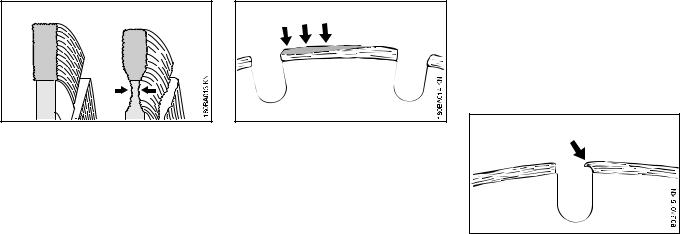
English / USA
Undercut |
Built-up edges, dressing |
Diamond cutting wheels must be |
|
|
"dressed" at the first sign of built-up |
|
|
edges. For this purpose, briefly cut a |
|
|
more abrasive material, such as |
|
|
sandstone, aerated concrete or asphalt. |
|
|
Wet cutting helps to prevent the |
|
|
formation of built-up edges. |
Undercutting is a wearing away of the steel core at or just below the diamond segments. When cutting road surfaces, do not cut through into the more abrasive ballast (gravel, crushed rock) below, as indicated by a light colored dust. This can cause excessive undercutting, resulting in wheel breakage and/or thrown segments.
!Warning!
Immediately replace a diamond wheel if the core has been severely undercut
Built-up edges are identified by a pale grey deposit on the top of the diamond segments that clogs and blunts the segments.
Built-up edges can form:
–when cutting extremely hard material, such as granite,
–as a result of incorrect handling, such as applying excessive feed force,
–if extremely large sections are cut without a pendulum movement (back and forth in the cutting plane).
Built-up edges increase vibrations, reduce cutting performance and cause sparking.
If you continue to use a cutting wheel with blunt segments, the segments may soften as a result of excessive heat built up. The wheel core will also overheat and lose its mechanical strength. This can lead to considerable stress, as clearly indicated by stress cracks and/or a wobbling movement of the cutting wheel.
!Warning!
Such cutting wheels may break apart or throw off segments during use, causing serious or fatal injury. Replace them immediately.
24 |
TS 460 |
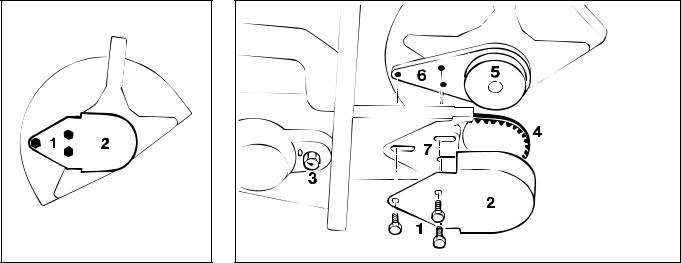
English / USA
Assembling the bearing and guard
337BA018 LA
:Unscrew the hexagon bolts (1) from the bearing with guard and remove the V-belt guard (2)
The bearing with guard can be mounted on the inboard or outboard side of the cast arm, depending on requirements.
Assembly on the inboard side is recommended for freehand cutting on account of the better balance; outboard mounting is recommended when the machine is mounted on a STIHL cut-off machine cart.
337BA019 LA
Assembly
(Inboard mounting is illustrated in the diagram)
:The arrow on the tensioning nut (3) must point to "0" – otherwise
:turn the tensioning nut approx. 1/4 turn counterclockwise as far as the stop = "0" with the combination wrench
:Place the V-belt (4) on the V-belt pulley (5)
:Line up the threaded bores in the bearing plate (6) with the slots in the cast arm (7)
:Fit the V-belt guard (2)
:Screw in the hexagon bolts (1) as far as the stop, but do not tighten them yet
Continue as described under "Tensioning the V-belt"
TS 460 |
25 |
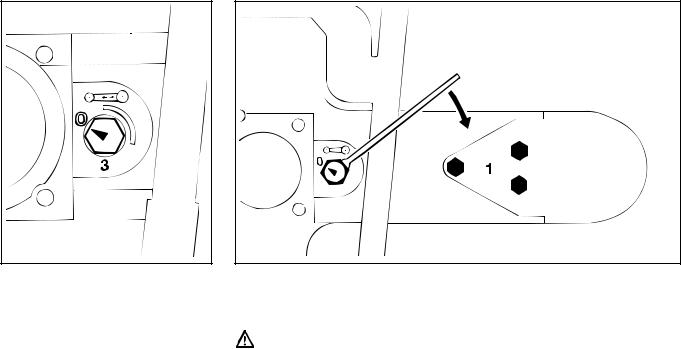
English / USA
Tensioning the V-belt
337BA020LA |
This machine is equipped with an automatic, spring-loaded V-belt tensioning device.
Before tensioning the V-belt, the
:hexagon bolts (1) must be unscrewed and the arrow on the tensioning nut (3) must point to "0", otherwise:
:Unscrew the hexagon bolts and turn the tensioning nut approx. 1/4 turn counterclockwise as far as the stop = "0" with the combination wrench
337BA021LA |
To tension the V-belt,
:fit the combination wrench over the tensioning nut as illustrated
The tensioning nut is spring-loaded – the combination wrench must therefore be held securely!
:Turn the tensioning nut clockwise. The spring force begins to act on the tensioning nut after approx. 1/8 turn; it is then turned on as far as the stop (approx. 1/8 turn)
Do not use force to turn the combination wrench!
The V-belt is automatically tensioned by the force of the spring in this position.
:Remove the combination wrench and tighten the hexagon bolts (1)
Retensioning
The V-belt is retensioned without adjusting the tensioning nut.
:Unscrew the hexagon bolts (1)
The V-belt is automatically tensioned by the force of the spring.
:Retighten the hexagon bolts
26 |
TS 460 |
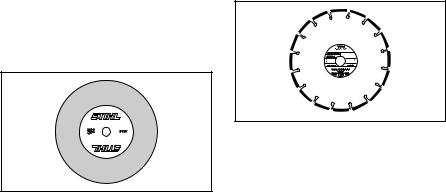
English / USA
Abrasive wheels
The abrasive wheels are subjected to extremely high loads, especially when cutting free-hand.
The abrasive wheels developed by STIHL in cooperation with leading wheel manufacturers are of very high quality and precisely matched to the application in question, as well as to the engine power of the respective cut-off machines.
They are of consistently outstanding quality, with high axial and radial runout.
Transport and storage
–The abrasive wheels must not be exposed to direct sunlight or other sources of heat during transport and storage
–Avoid knocks and bumps
–Spare abrasive wheels must be stored in a dry place at constant temperature, stacked one on top of the other on a flat surface, in their original packaging.
–Diamond abrasive wheels must not be stored near corrosive liquids
–Composite abrasive wheels must be protected against frost
Choosing an abrasive wheel
STIHL abrasive wheels can be used to cut the following materials:
002BA139 KN
Composite abrasive wheels
(depending on type) can be used for
–Asphalt
–Concrete
–Stone
–Ductile cast pipes
–Steel
002BA140 KN
Diamond abrasive wheels
(depending on type) can be used for
–Asphalt
–Concrete
–Stone (hard rock)
–Abrasive concrete
–Green concrete
–Clay bricks
–Clay pipes
Diamond abrasive wheels cannot be used to cut metal.
TS 460 |
27 |
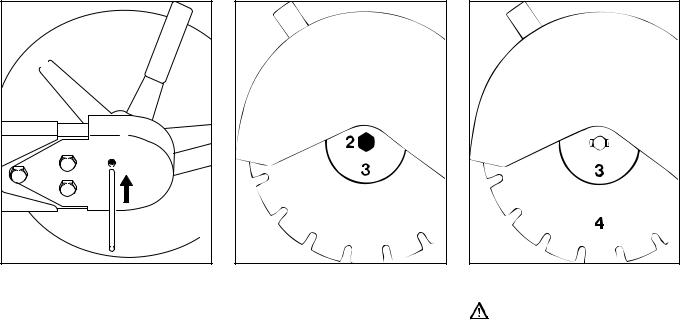
English / USA
Fitting / replacing an abrasive wheel
1 |
338BA006 |
The engine must be switched off when fitting or replacing an abrasive wheel – slide control / stop switch to "0" or c
In order to block the arbor,
:slide the locking pin (1) through the bore in the V-belt guard (turn the arbor a short distance with the combination wrench if necessary) until the locking pin engages in one of the bores behind the guard.
:Use the combination wrench to loosen and unscrew the hexagon bolt (2).
:Remove the front thrust washer (3) from the arbor together with the abrasive wheel to be replaced.
|
338BA008 |
: |
Fit the abrasive wheel (4). |
Note the arrows indicating the sense of rotation on diamond abrasive wheels.
:Fit the front thrust washer (3). The catches of the front thrust washer must engage in the arbor grooves.
:Fit the hex head screw and tighten it down firmly with the combination wrench (or to about 30 Nm if you use a torque wrench)
:Draw the locking pin out of the V-belt guard.
28 |
TS 460 |



 Two diamond wheels of the same type can also be used together if a wider cut is required (e.g. for laying induction loops in carriageways).
Two diamond wheels of the same type can also be used together if a wider cut is required (e.g. for laying induction loops in carriageways).
It is essential to ensure that the segments are positioned exactly side by side in such a case.
However, two composite abrasive wheels must never be used simultaneously, for they can break and cause injuries as they wear down unevenly.
Fuel
This engine is certified to operate on unleaded gasoline and the STIHL twostroke engine oil at a mix ratio of 50:1.
Your engine requires a mixture of highquality gasoline and quality two-stroke air cooled engine oil.
Use mid-grade unleaded gasoline with a minimum octane rating of 89 (R+M/2). If the octane rating of the mid-grade gasoline in your area is lower, use premium unleaded fuel.
Fuel with a lower octane rating may increase engine temperatures. This, in turn, increases the risk of piston seizure and damage to the engine.
The chemical composition of the fuel is also important. Some fuel additives not only detrimentally affect elastomers (carburetor diaphragms, oil seals, fuel lines, etc.), but magnesium castings and catalytic converters as well. This could cause running problems or even damage the engine. For this reason STIHL recommends that you use only nationally recognized high-quality unleaded gasoline!
English / USA
Use only STIHL two-stroke engine oil or equivalent high-quality two-stroke engine oils that are designed for use only in air cooled two-cycle engines.
We recommend STIHL 50:1 two-stroke engine oil since it is specially formulated for use in STlHL engines.
Do not use BIA or TCW rated (twostroke water cooled) mix oils or other mix oils that state they are for use in both water cooled and air cooled engines (e.g., outboard motors, snowmobiles, chainsaws, mopeds, etc.).
Take care when handling gasoline. Avoid direct contact with the skin and avoid inhaling fuel vapor. When filling at the pump, first remove the canister from your vehicle and place the canister on the ground before filling. Do not fill fuel canisters that are sitting in or on a vehicle.
The canister should be kept tightly closed in order to avoid any moisture getting into the mixture.
The machine‘s fuel tank and the canister in which fuel mix is stored should be cleaned as necessary.
TS 460 |
29 |
